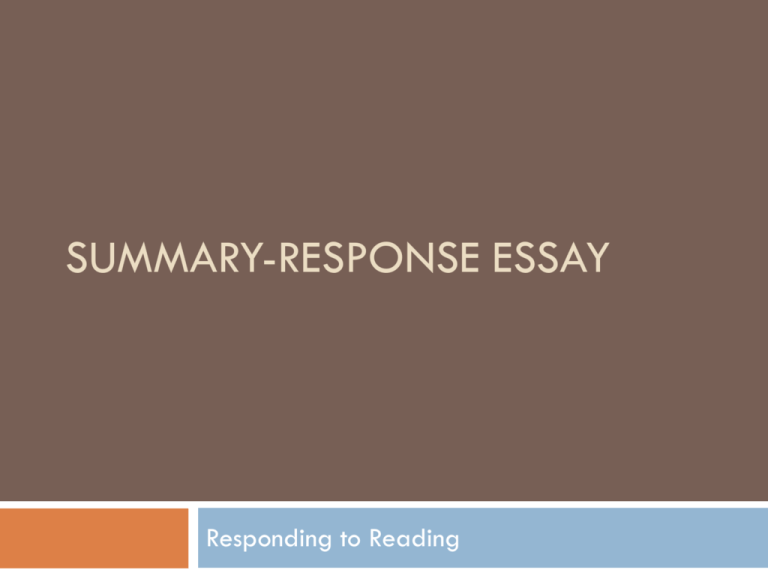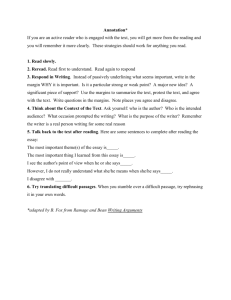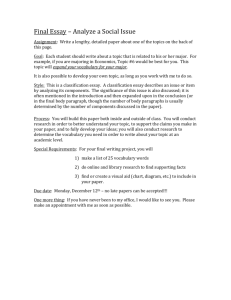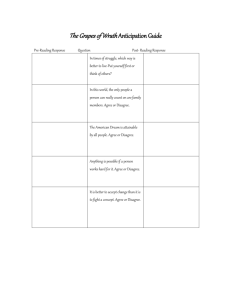PowerPoint Presentation - Summary
advertisement

SUMMARY-RESPONSE ESSAY Responding to Reading Reading Critically Not about finding fault with author Rather engaging author in a discussion by asking questions as you read an article or essay Requiring author to meet certain demands that employ good writing techniques: How to read critically Good note taking Keep a Reader’s log Author’s Name and title of Article Summary: List main ideas, key features, examples, and evidence the author may provide Response: Log your reaction to each main point, record your comments, and questions Purpose of this Essay To understand an author’s main idea and purpose for work To recognize the main points that support that main idea To be able to summarize(paraphrase) author’s main ideas To be able to respond or react to what the author has to say (to support or defend your point of view) Preparing the Summary Cite the author and the title of the text Indicate the main ideas of the text Paraphrase main ideas; quote sparingly, use key words, phrases, and sentences Include attributive tags Avoid summarizing specific examples or data Be objective Response Your opinion of the author’s ideas Do you agree or disagree How well is the essay or article written? Structuring Your response Requires your reaction to the text and your interpretation of the text A response of this nature will react to the ideas or the argument Simply, do you agree with the author? Why or why not? Provide evidence based on your experiences to support your reaction 3 ways to provide evidence to support your response Your response requires that you provide evidence to support your opinion, whether you agree or disagree with the author Consider what sort of evidence will best support your statements: personal experience, evidence from text, outside sources 1. Personal Experience Use personal experience as examples to demonstrate why you interpret the text the way you do, why you react the way you do, why you agree or disagree I strongly disagree with so and so’s first point based on my own high school experience, especially in my History class. Look at Abramowitz’s essay for examples of her personal experiences. 2. Evidence from the text Cite specific phrases or sentences from the text to support your: explanation of the text analysis of the effectiveness of the text response to the text (why you agree or disagree) Look at Abromowitz’s essay for examples of her using evidence from the text 3. Evidence from other texts Acceptable to bring in ideas and information from other texts Your prior knowledge No research required for this assignment Cite sources if you do use borrow material from other sources Look at Abramowitz’s essay for examples of her using outside texts or sources. Introduction Brief introduction that will state these items: Title of the article or essay; Name of author; Place of publication Any key information you might know about author to help establish author’s credibility State author’s main idea Thesis: a well thought out statement stating your main point about the article or essay. Body Organization: Block Pattern 1 I. Introduction with thesis II. Summary of main point III. Points You agree with IV. Points you disagree with Conclusion Body Organization: Point by Point I. Introduction with thesis Summarize point 1; agree or disagree Summarize point 2; agree or disagree Summarized point 3; agree or disagree Conclusion Note: you do not need to agree or disagree with all points Conclusion End essay with a summary of your response You can add a new perspective about the article, author, or topic Important things to remember Make sure to give reasons why you disagree Give examples, personal experience, facts, any previous experience or knowledge you can draw upon to support your opinion Based on my experience with boys in class in high school. . . . Try to avoid over using “I agree” and “I disagree” The Summary: Discuss the Points that Feagin makes in groups Denying Individual Racism White Views on Government Action Against Racism Symbolic and Laissez Faire Racism Views on Affirmative Action Imaging the White Self Fostering and Learning Racist Attitudes Role of Elites Everyday Racism: Subtle, Covert, and Blatant Who Does the Discriminating? Facing Lifetimes of Racial Discrimination Racial Discrimination in Public Places Denying Individual Racism Slavery ended a long time ago Institutionalized racism ended after the Civil Rights movement Racism is something that other people are i.e.) grandparents, parents, KKK members Symbolic and Laissez Faire Racism Symbolic Whites have replaced blatant racism with a more subtle form Whites believe blacks are making “illegitimate demands for societal changes” (Feagin 342). Criticized for not acknowledging that blatant racism still exists Laissez Faire Whites have embraced the principle of desegregation but are opposed to government intervention or actual changes that involve living and going to school with black people. Allows whites to feel good about themselves Affirmative Action Whites believe affirmative action is not needed b/c racism is dead. Whites believe that if blacks aren’t successful, it’s b/c they don’t work hard enough. White elites shape views on this issue: For example, media attention of this issue goes up in the years preceding presidential elections Imaging the white self Whites see white culture as superior. Whites don’t see financial benefits from slavery and segregation “My family didn’t own slaves.” Role of Elites in Fostering Racist Attitudes Without realizing it, many white people harbor negative attitudes towards blacks These ideas are fostered by an elite few through the media, schools, and even churches Everyday Racism White people may not be aware of their racism May grab purse or lock door when a black man walks by White employer might hire a white man over an equally qualified black man b/c he feels more comfortable with his own kind Who Does the Discriminating? 3 types of racist whites Blatant-KKK Less subtle forms Don’t directly participate but don’t stop it White upper/middle class Americans affect housing and jobs Lower classes are more violent Facing Lifetimes of Racial Discrimination No way to tell impact of racism Little research Black people don’t want to appear weak Black people don’t count small examples of racism Racial Discrimination in Public Whites assume blacks are going to steal Whites charge more for cars White medical professionals less likely to use expensive procedures on black patients Respond to major points: Points you agree with(Students will list) 1 2 3 Experiences or knowledge that support your agreement 1 2 3 Respond to major points: Points you disagree with 1 2 3 Experiences or knowledge that support your agreement 1 2 3




